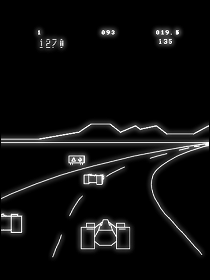 The Game: Prepare to qualify! Fly to the finish line in a fierce field of Formula One competitors in a qualifying lap. Leaving the track is trouble – and hitting one of the billboards dotted around the edges of the Mt. Fuji track is a sure way to miss out on the subsequent race. (GCE, 1983)
The Game: Prepare to qualify! Fly to the finish line in a fierce field of Formula One competitors in a qualifying lap. Leaving the track is trouble – and hitting one of the billboards dotted around the edges of the Mt. Fuji track is a sure way to miss out on the subsequent race. (GCE, 1983)
Memories: When GCE (and, briefly, the eager-to-get-into-the-video-game-business Milton Bradley) debuted the Vectrex, any argument that there was another system better-suited for home ports of arcade vector graphics games was over, period. With willing licensing partners like Cinematronics, Vectrex was a shoo-in. There’s only one problem: by 1983, vector graphics were rapidly falling out of wide use as more advanced raster graphics technology, driven by faster processors, came into play. What games would Vectrex play then?
In an unusual and risky move, GCE began seeking licenses from outside the obvious parameters, landing the rights to do Vectrex ports of games that had originated with raster graphics, such as Stern’s Berzerk and Atari/Namco’s Pole Position. Getting the rights to the latter wasn’t easy, and involved dealing directly with Namco; no other  Atari title had appeared on Vectrex to date, despite the wealth of Atari titles that would’ve been uniquely well-suited to that platform (i.e. Asteroids, Tempest, Space Duel, Major Havoc…).
Atari title had appeared on Vectrex to date, despite the wealth of Atari titles that would’ve been uniquely well-suited to that platform (i.e. Asteroids, Tempest, Space Duel, Major Havoc…).
Where Vectrex still had an edge, at least for the moment, was in its ability to draw detailed graphics sharper and faster than the other home consoles on the market could manage. Atari had its own lumpen ports of Pole Position on the store shelves already for the 2600 and 5200, but both games sacrificed Pole Position‘s signature graphical beauty for speed – a surprising trade-off when the 5200 was supposedly much more powerful than its older sibling. Vectrex couldn’t draw screen-filling, full-color graphics, but it could do speed and detail at the same time.
The result is a unique take on Pole Position which, while not colorful by any stretch, does manage to include many of the game’s trademarks: a “prepare to qualify” banner floats above the track, Mt. Fuji in the background, billboards whizzing past the player’s perspective. And it’s actually very playable, with the one major drawback being that the Vectrex controller is about as well-suited to a driving game as, well, the 2600 controller. One other stumbling block may have been that GCE’s already-released first-person driver Hyper Chase already had Pole Position trumped for its sheer variety of landscapes, environments and hazards.
It may not be the best-remembered home version of Pole Position, but  Vectrex’s moment behind the coin-op steering wheel was a brave attempt to show that Vectrex might still have relevance in a world where coin-op designers were outgrowing vector graphics. Sadly, before many more bold experiments like this could be produced, the crash of the video game industry gave GCE and everyone else much bigger problems to worry about.
Vectrex’s moment behind the coin-op steering wheel was a brave attempt to show that Vectrex might still have relevance in a world where coin-op designers were outgrowing vector graphics. Sadly, before many more bold experiments like this could be produced, the crash of the video game industry gave GCE and everyone else much bigger problems to worry about.
